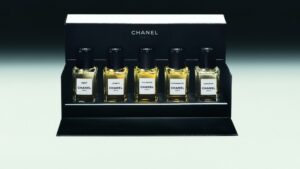Chanel recently made the decision to close its Atelier Beauté location in Manhattan’s SoHo, a move that reflects both a strategic shift and a broader trend in the luxury retail space. The Atelier Beauté, which opened in 2019, was more than just a store; it was designed as an innovative, immersive environment that aimed to enhance customer experience with the brand. According to Chanel, this site provided a digitally-driven space that allowed clients to engage with products in new ways. However, the brand has now chosen to incorporate this innovation into its existing fragrance and beauty operational model. This suggests a pivot toward enhancing the traditional retail framework rather than maintaining a dedicated experimental outlet.
The Atelier Beauté featured a unique sensory journey that included an experiential fragrance room and various beauty services like makeup application and brow styling. It aimed to create a comprehensive beauty experience in the bustling heart of Manhattan. While the concept was groundbreaking, the decision to close indicates that Chanel may be shifting its focus back to more conventional methods of engagement, prioritizing both exceptional service and innovative approaches that align closely with customer preferences.
In the wider context, Chanel has been seeing positive growth in its beauty sector, with estimated sales reaching around $8.54 billion in 2024. This growth has been primarily driven by face makeup, showing a trend where consumers are investing more in beauty products that enhance their appearance. Despite a flat performance in the fragrance segment, the overall trajectory for Chanel’s beauty business remains upward. This resilience highlights the importance of adapting to market demands while maintaining brand integrity.
Interestingly, Chanel isn’t entirely stepping away from experiential retail. In the same year that it closed the Atelier Beauté, the brand launched 26 new fragrance and beauty hubs globally. One notable example is the House of Beauty in Paris, which combines a full range of beauty products with treatment offerings like facials and body treatments. The brand seems to understand the need for a balance between memorable customer experiences and streamlined operations, signaling a nuanced approach to retail strategy.
Despite the closing of the SoHo location, Chanel is not retreating from New York. In 2023, the brand opened another boutique dedicated to fragrance and beauty in Williamsburg, demonstrating its commitment to maintaining a strong physical presence in key markets. This move aligns with Chanel’s goal of connecting with its online clientele and fostering new relationships in areas with potential growth. The transition in leadership, with Barbara Menarguez retiring and Emilie de Tramasure taking over, hints at a fresh perspective as the brand navigates these changes.
Within the luxury retail landscape, there is a noticeable trend where brands like Dior and Hourglass are doubling down on physical stores. With many luxury brands investing in standalone boutiques, Chanel’s decision reflects a broader industry pattern that underscores a renewed focus on the in-person shopping experience. This dynamic suggests that even as Chanel adapts its operational model, it remains committed to creating intimate and engaging customer interactions, ensuring that the essence of the brand remains intact. Ultimately, the successful integration of tradition and innovation will be crucial for Chanel in the evolving landscape of luxury retail.


